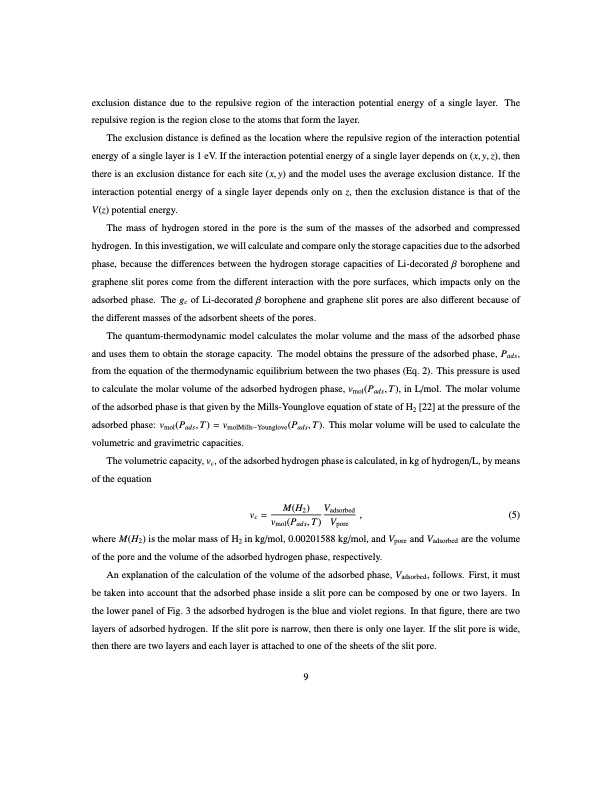
PDF Publication Title:
Text from PDF Page: 011
exclusion distance due to the repulsive region of the interaction potential energy of a single layer. The repulsive region is the region close to the atoms that form the layer. The exclusion distance is defined as the location where the repulsive region of the interaction potential energy of a single layer is 1 eV. If the interaction potential energy of a single layer depends on (x, y, z), then there is an exclusion distance for each site (x, y) and the model uses the average exclusion distance. If the interaction potential energy of a single layer depends only on z, then the exclusion distance is that of the V(z) potential energy. The mass of hydrogen stored in the pore is the sum of the masses of the adsorbed and compressed hydrogen. In this investigation, we will calculate and compare only the storage capacities due to the adsorbed phase, because the differences between the hydrogen storage capacities of Li-decorated β borophene and graphene slit pores come from the different interaction with the pore surfaces, which impacts only on the adsorbed phase. The gc of Li-decorated β borophene and graphene slit pores are also different because of the different masses of the adsorbent sheets of the pores. The quantum-thermodynamic model calculates the molar volume and the mass of the adsorbed phase and uses them to obtain the storage capacity. The model obtains the pressure of the adsorbed phase, Pads, from the equation of the thermodynamic equilibrium between the two phases (Eq. 2). This pressure is used to calculate the molar volume of the adsorbed hydrogen phase, vmol(Pads,T), in L/mol. The molar volume of the adsorbed phase is that given by the Mills-Younglove equation of state of H2 [22] at the pressure of the adsorbed phase: vmol(Pads,T) = vmolMills−Younglove(Pads,T). This molar volume will be used to calculate the volumetric and gravimetric capacities. The volumetric capacity, vc, of the adsorbed hydrogen phase is calculated, in kg of hydrogen/L, by means of the equation vc = M(H2) Vadsorbed , (5) vmol(Pads,T) Vpore where M(H2) is the molar mass of H2 in kg/mol, 0.00201588 kg/mol, and Vpore and Vadsorbed are the volume of the pore and the volume of the adsorbed hydrogen phase, respectively. An explanation of the calculation of the volume of the adsorbed phase, Vadsorbed, follows. First, it must be taken into account that the adsorbed phase inside a slit pore can be composed by one or two layers. In the lower panel of Fig. 3 the adsorbed hydrogen is the blue and violet regions. In that figure, there are two layers of adsorbed hydrogen. If the slit pore is narrow, then there is only one layer. If the slit pore is wide, then there are two layers and each layer is attached to one of the sheets of the slit pore. 9PDF Image | Hydrogen storage capacity of Li-decorated borophene

PDF Search Title:
Hydrogen storage capacity of Li-decorated boropheneOriginal File Name Searched:
APSUSC-D-20-15170.pdfDIY PDF Search: Google It | Yahoo | Bing
CO2 Organic Rankine Cycle Experimenter Platform The supercritical CO2 phase change system is both a heat pump and organic rankine cycle which can be used for those purposes and as a supercritical extractor for advanced subcritical and supercritical extraction technology. Uses include producing nanoparticles, precious metal CO2 extraction, lithium battery recycling, and other applications... More Info
Heat Pumps CO2 ORC Heat Pump System Platform More Info
| CONTACT TEL: 608-238-6001 Email: greg@infinityturbine.com | RSS | AMP |